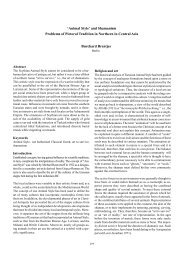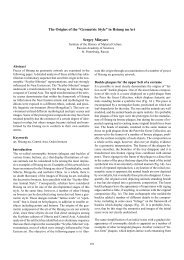Part II Archaeological Excavations - Center for the Study of Eurasian ...
Part II Archaeological Excavations - Center for the Study of Eurasian ...
Part II Archaeological Excavations - Center for the Study of Eurasian ...
You also want an ePaper? Increase the reach of your titles
YUMPU automatically turns print PDFs into web optimized ePapers that Google loves.
Kurgans, Ritual Sites, and Settlements: <strong>Eurasian</strong> Bronze and Iron Age<br />
Methodology<br />
In <strong>the</strong> field, samples were taken from sediments that contained<br />
charcoal fragments and pieces <strong>of</strong> wood. The charcoal and wood<br />
were separated from <strong>the</strong> sediments in <strong>the</strong> laboratory by sieving<br />
(to 2 mm) and flotation. The woody material was <strong>the</strong>n observed<br />
under <strong>the</strong> microscope and identified on <strong>the</strong> basis <strong>of</strong> <strong>the</strong> wood<br />
structure (Schweingruber 1990). The species and diversity revealed<br />
<strong>the</strong> types <strong>of</strong> wood chosen <strong>for</strong> use by <strong>the</strong> population, in<br />
addition to <strong>the</strong> particular methods <strong>of</strong> exploitation <strong>for</strong> <strong>the</strong> different<br />
types <strong>of</strong> wood.<br />
When possible, <strong>the</strong> growth ring widths were systematically<br />
measured. This data can provide in<strong>for</strong>mation on <strong>the</strong> growing<br />
conditions <strong>of</strong> <strong>the</strong> trees, including climate, <strong>the</strong> type <strong>of</strong> soil, and<br />
<strong>the</strong> density <strong>of</strong> <strong>the</strong> <strong>for</strong>est. Narrow rings correspond to restrictive<br />
growing conditions, while, in contrast, large rings reveal favorable<br />
growing conditions.<br />
In <strong>the</strong> field, cores were made in living birch, pine and poplar<br />
trees growing in different types <strong>of</strong> environment. The purpose<br />
<strong>of</strong> obtaining <strong>the</strong>se samples was to enable a comparison to be<br />
made between <strong>the</strong> ring widths <strong>of</strong> living trees with those observed<br />
in <strong>the</strong> subfossil samples. The relationship between modern<br />
tree ring patterns and <strong>the</strong>ir environments can provide in<strong>for</strong>mation<br />
on <strong>the</strong> origin <strong>of</strong> <strong>the</strong> wood charcoal recovered during<br />
archaeological excavations.<br />
Finally, when possible, <strong>the</strong> tree ring curves <strong>of</strong> <strong>the</strong> charcoal pieces<br />
were noted. This characteristic can enable <strong>the</strong> identification <strong>of</strong><br />
which part <strong>of</strong> a tree was used (Marguerie 1992). A smooth curve<br />
corresponds to <strong>the</strong> tree trunk, while a marked curve corresponds<br />
to <strong>the</strong> branches.<br />
Results<br />
The results appeared to be very homogenous between <strong>the</strong><br />
samples from a given site regardless <strong>of</strong> <strong>the</strong> method <strong>of</strong> analysis<br />
(species diversity, tree growth, and tree element). For <strong>the</strong> first<br />
approach to <strong>the</strong> problem, <strong>the</strong> samples were grouped by site.<br />
Note that graphs <strong>for</strong> some sites are not presented, especially<br />
<strong>for</strong> tree growth and tree elements, because <strong>the</strong>re was no data or<br />
too little data <strong>for</strong> <strong>the</strong> results to be representative.<br />
Species diversity<br />
No major differences between <strong>the</strong> charcoal species identified<br />
from <strong>the</strong> settlements and <strong>the</strong> burials sites were noted (Fig. 3).<br />
Pine and birch were <strong>the</strong> most common species recovered from<br />
all sites. These two species were found to occur exclusively at<br />
<strong>the</strong> Prygovsky and Scaty sites. In addition to <strong>the</strong>se two <strong>for</strong>est<br />
trees, river bank taxa were also found to be present at <strong>the</strong> B.<br />
Kazakbaievo site and, to a lesser degree, at <strong>the</strong> Gaiova and<br />
Baitovo sites. At Malakazakbaievo, however, no pine samples<br />
were found, and because <strong>of</strong> its diverse species assemblage without<br />
pine, <strong>the</strong> Malakazakbaievo site appears to be unique.<br />
Tree growth<br />
The distribution <strong>of</strong> birch ring widths is wide, particularly at <strong>the</strong><br />
Skaty and Baitovo sites, <strong>the</strong> two sites situated along <strong>the</strong> Tobol<br />
76<br />
River (Fig. 4a). This finding may indicate that <strong>the</strong> samples had<br />
probably originated from many <strong>for</strong>est types, which contained<br />
a variety <strong>of</strong> growing conditions. In contrast, <strong>the</strong> coarse range<br />
<strong>of</strong> <strong>the</strong> pine ring width distributions probably means that <strong>the</strong><br />
Iron Age populations only retrieved pines from one particular<br />
<strong>for</strong>est type characterized by specific growing conditions. The<br />
only possible exception to this situation is found at <strong>the</strong> Gaiova<br />
site (Fig. 4b).<br />
If <strong>the</strong> measurements made on living samples are compared with<br />
<strong>the</strong> mean values per site <strong>of</strong> <strong>the</strong> subfossil material, more in<strong>for</strong>mation<br />
can be gleaned concerning <strong>the</strong> nature <strong>of</strong> <strong>the</strong> environment<br />
in which <strong>the</strong> trees were grown. In <strong>the</strong> case <strong>of</strong> birch (Fig.<br />
5a), <strong>the</strong> analysis <strong>of</strong> living trees would tend to indicate that narrow<br />
rings are found in coppice <strong>for</strong>mations, while large rings<br />
are found in humid <strong>for</strong>ests. Medium ring widths (values in between<br />
<strong>the</strong> narrow and large rings observed in living trees) were<br />
observed on <strong>the</strong> birch charcoal (subfossil material), making it<br />
difficult to draw conclusions concerning <strong>the</strong> nature <strong>of</strong> <strong>the</strong> environment<br />
from which <strong>the</strong> trees had originated.<br />
The results appear to be clearer in <strong>the</strong> case <strong>of</strong> pine charcoal<br />
(Fig. 5b). Cores made in living pines show two patterns <strong>of</strong><br />
growth depending on <strong>the</strong> <strong>for</strong>est type - c. 0.5mm radial growth<br />
per year in an ancient <strong>for</strong>est, and 2–3 mm in exploited small<br />
<strong>for</strong>ests located near rivers. The rings <strong>of</strong> <strong>the</strong> pine charcoal<br />
samples (subfossil material) have, in general, an average width<br />
<strong>of</strong> approximately 1 mm. At Scaty, however, <strong>the</strong> pines were found<br />
to have very narrow rings with a mean width <strong>of</strong> less than<br />
0.5mm. There<strong>for</strong>e, it would appear that <strong>the</strong> Iron Age people<br />
probably collected <strong>the</strong>se trees from fully developed <strong>for</strong>ests. This<br />
type <strong>of</strong> <strong>for</strong>est environment leads to restrictive growing conditions<br />
which are related to <strong>the</strong> competition which exists between<br />
trees <strong>for</strong> nutriments, light, water, etc.<br />
Tree elements<br />
At <strong>the</strong> Prygovsky, Gaiova, and Malakazakhbaievo sites, results<br />
obtained from <strong>the</strong> tree ring curves indicate that <strong>the</strong> birch charcoals<br />
had originated equally from trunks and branches (Fig.<br />
6a). In <strong>the</strong> case <strong>of</strong> pine, all tree elements were also used at <strong>the</strong><br />
Prygovsky and Gaiova sites (Fig. 6b). In contrast, at Baitovo<br />
and Scaty, in most cases, <strong>the</strong> pine and birch charcoals had originated<br />
from tree trunks. This finding may indicate that <strong>the</strong> Iron<br />
Age people had deliberately selected large pieces <strong>of</strong> wood at<br />
<strong>the</strong>se two sites located along <strong>the</strong> Tobol River.<br />
Discussion and Conclusions<br />
The data obtained from charcoal analyses can provide pertinent<br />
ecological in<strong>for</strong>mation. In comparison to <strong>the</strong> actual living<br />
regional vegetation, our results seem to show that, during <strong>the</strong><br />
Iron Age, <strong>the</strong> <strong>for</strong>ests were composed <strong>of</strong> <strong>the</strong> same species as<br />
today, namely pine and birch trees. In <strong>the</strong> samples obtained<br />
from <strong>the</strong> Malakazakhbaievo site, however, pines was conspicuously<br />
absent. Following <strong>the</strong> hypo<strong>the</strong>sis that <strong>the</strong> presence <strong>of</strong> a<br />
tree species near a site (particularly at settlements such as those<br />
<strong>of</strong> <strong>the</strong> current study) results in its exploitation by <strong>the</strong> population,<br />
it is possible to infer that pines were not available at <strong>the</strong>





